Cross-Examining Precipitation Products by Rain Gauge, Remote Sensing, and WRF Simulations over a South American Region across the Pacific Coast and Andes
Abstract
1. Introduction
2. Materials and Methods
2.1. Study Area
2.2. Precipitation Products
2.2.1. Rain Gauge
2.2.2. GPM IMERG
2.2.3. MSWEP
2.2.4. GPCC Monthly Precipitation
2.2.5. WRF Simulation
2.3. Statistical Metrics
2.4. Triple Colocation (TC) Method
3. Results
3.1. Annual Mean of Precipitation Products
3.2. Daily Ground Observation Evaluations
3.2.1. Daily Analysis over Different Climate Zones in Peru
3.2.2. Seasonal Statistical Results in Different Climate Zones
3.3. Statistical Cross-Examination at Sub-Daily Scale
3.4. Monthly MTC Results
4. Discussion
5. Conclusions
- For dryer climates, such as desert, grassland, and tundra, WRF-simulated precipitation was as accurate if not better than satellite or multi-source global precipitation observations, at sub-daily, daily, and monthly scales. However, for wetter regions where higher intensity precipitation events occur, WRF simulation had the highest level of uncertainty compared to other precipitation products.
- This study confirmed the previous study that the MSWEP precipitation product had a systematic overestimation over the study region but had a low temporal correlation error.
- GPM IMERG had more accurate precipitation estimates on the east slope (upwind) of the Andes than the west slope (downwind). IMERG had good performance over the Amazon basin. Considering that there is lack of human access and meteorological instruments in the Amazon rainforest, the GPM IMERG could be a useful dataset available for studies over the Amazon Basin.
Author Contributions
Funding
Institutional Review Board Statement
Informed Consent Statement
Data Availability Statement
Conflicts of Interest
Appendix A
References
- Bayissa, Y.; Tadesse, T.; Demisse, G.; Shiferaw, A. Evaluation of Satellite-Based Rainfall Estimates and Application to Monitor Meteorological Drought for the Upper Blue Nile Basin, Ethiopia. Remote Sens. 2017, 9, 669. [Google Scholar] [CrossRef]
- Garreaud, R.D.; Vuille, M.; Compagnucci, R.; Marengo, J. Present-Day South American Climate. Palaeogeogr. Palaeoclimatol. Palaeoecol. 2009, 281, 180–195. [Google Scholar] [CrossRef]
- Hunziker, S.; Gubler, S.; Calle, J.; Moreno, I.; Andrade, M.; Velarde, F.; Ticona, L.; Carrasco, G.; Castellón, Y.; Oria, C.; et al. Identifying, Attributing, and Overcoming Common Data Quality Issues of Manned Station Observations: Identifying, Attributing, and Overcoming Common Data Quality Issues. Int. J. Climatol. 2017, 37, 4131–4145. [Google Scholar] [CrossRef]
- Alijanian, M.; Rakhshandehroo, G.R.; Mishra, A.K.; Dehghani, M. Evaluation of Satellite Rainfall Climatology Using CMORPH, PERSIANN-CDR, PERSIANN, TRMM, MSWEP over Iran. Int. J. Clim. 2017, 37, 4896–4914. [Google Scholar] [CrossRef]
- Huffman, G.; Bolvin, D.; Braithwaite, D.; Hsu, K.; Joyce, R.; Xie, P. Integrated Multi-SatellitE Retrievals for GPM (IMERG). In Vers. 4.4. NASA’s Precipitation Processing Center; NASA: Greenbelt, MD, USA, 2014. [Google Scholar]
- Huffman, G.J.; Adler, R.F.; Morrissey, M.M.; Bolvin, D.T.; Curtis, S.; Joyce, R.; McGavock, B.; Suzzkind, J. Global Precipitation at One-Degree Daily Resolution from Multisatellite Observations. J. Hydrometeorol. 2001, 2, 36–50. [Google Scholar] [CrossRef]
- Huffman, G.J.; Bolvin, D.T.; Braithwaite, D.; Hsu, K.; Joyce, R.; Kidd, C.; Nelkin, E.J.; Sorooshain, S.; Tan, J.; Xie, P. Developing the Integrated Multi-Satellite Retrievals for GPM (IMERG). In Proceedings of the EGU General Assembly, Vienna, Austria, 22–27 April 2012; EGU: Vienna, Austria, 2012; p. 6921. [Google Scholar]
- Huffman, G.J.; Bolvin, D.T.; Nelkin, E.J.; Stocker, E.F.; Tan, J. V06 IMERG Release Notes, NASA, Greenbelt MD 2019. Available online: https://gpm.nasa.gov/resources/documents/imerg-v06-release-notes (accessed on 1 February 2022).
- Joyce, R.J.; Janowiak, J.E.; Arkin, P.A.; Xie, P. CMORPH: A Method That Produces Global Precipitation Estimates from Passive Microwave and Infrared Data at High Spatial and Temporal Resolution. J. Hydrometeor 2004, 5, 487–503. [Google Scholar] [CrossRef]
- Sorooshian, S.; Hsu, K.-L.; Gao, X.; Gupta, H.V.; Imam, B.; Braithwaite, D. Evaluation of PERSIANN System Satellite–Based Estimates of Tropical Rainfall. Bull. Amer. Meteor. Soc. 2000, 81, 2035–2046. [Google Scholar] [CrossRef]
- Hong, Y.; Gochis, D.; Cheng, J.-T.; Hsu, K.; Sorooshian, S. Evaluation of PERSIANN-CCS Rainfall Measurement Using the NAME Event Rain Gauge Network. J. Hydrometeorol. 2007, 8, 469–482. [Google Scholar] [CrossRef]
- Kubota, T.; Shige, S.; Hashizume, H.; Aonashi, K.; Takahashi, N.; Seto, S.; Hirose, M.; Takayabu, Y.N.; Ushio, T.; Nakagawa, K.; et al. Global Precipitation Map Using Satellite-Borne Microwave Radiometers by the GSMaP Project: Production and Validation. IEEE Trans. Geosci. Remote Sens. 2007, 45, 2259–2275. [Google Scholar] [CrossRef]
- Derin, Y.; Anagnostou, E.; Berne, A.; Borga, M.; Boudevillain, B.; Buytaert, W.; Chang, C.-H.; Delrieu, G.; Hong, Y.; Hsu, Y.C.; et al. Multiregional Satellite Precipitation Products Evaluation over Complex Terrain. J. Hydrometeorol. 2016, 17, 1817–1836. [Google Scholar] [CrossRef]
- Derin, Y.; Anagnostou, E.; Berne, A.; Borga, M.; Boudevillain, B.; Buytaert, W.; Chang, C.-H.; Chen, H.; Delrieu, G.; Hsu, Y.; et al. Evaluation of GPM-Era Global Satellite Precipitation Products over Multiple Complex Terrain Regions. Remote Sens. 2019, 11, 2936. [Google Scholar] [CrossRef]
- Schneider, U.; Becker, A.; Finger, P.; Rustemeier, E.; Ziese, M. GPCC Full Data Monthly Version 2020 at 0.25°: Monthly Land-Surface Precipitation from Rain-Gauges Built on GTS-Based and Historic Data: Gridded Monthly Totals 2020, 5 MB–300 MB per Gzip Compressed NetCDF File; GPCC: Green Point, Australia, 2020. [Google Scholar]
- Schneider, U.; Becker, A.; Finger, P.; Meyer-Christoffer, A.; Ziese, M.; Rudolf, B. GPCC’s New Land Surface Precipitation Climatology Based on Quality-Controlled In Situ Data and Its Role in Quantifying the Global Water Cycle. Appl. Clim. 2014, 115, 15–40. [Google Scholar] [CrossRef]
- Schneider, U.; Becker, A.; Finger, P.; Meyer-Christoffer, A.; Rudolf, B.; Ziese, M. GPCC Full Data Reanalysis Version 7.0 at 0.5°: Monthly Land-Surface Precipitation from Rain-Gauges Built on GTS-Based and Historic Data: Gridded Monthly Totals 2015, 20–270 MB per Decadal Gzip Compressed NetCDF Archive; GPCC: Green Point, Australia, 2016. [Google Scholar]
- Wang, G.; Zhang, P.; Liang, L.; Zhang, S. Evaluation of Precipitation from CMORPH, GPCP-2, TRMM 3B43, GPCC, and ITPCAS with Ground-Based Measurements in the Qinling-Daba Mountains, China. PLoS ONE 2017, 12, e0185147. [Google Scholar] [CrossRef]
- Aybar, C.; Fernández, C.; Huerta, A.; Lavado, W.; Vega, F.; Felipe-Obando, O. Construction of a High-Resolution Gridded Rainfall Dataset for Peru from 1981 to the Present Day. Hydrol. Sci. J. 2020, 65, 770–785. [Google Scholar] [CrossRef]
- Funk, C.; Peterson, P.; Landsfeld, M.; Pedreros, D.; Verdin, J.; Shukla, S.; Husak, G.; Rowland, J.; Harrison, L.; Hoell, A.; et al. The Climate Hazards Infrared Precipitation with Stations—A New Environmental Record for Monitoring Extremes. Sci. Data 2015, 2, 150066. [Google Scholar] [CrossRef]
- Beck, H.E.; Wood, E.F.; Pan, M.; Fisher, C.K.; Miralles, D.G.; van Dijk, A.I.J.M.; McVicar, T.R.; Adler, R.F. MSWEP V2 Global 3-Hourly 0.1° Precipitation: Methodology and Quantitative Assessment. Bull. Am. Meteorol. Soc. 2019, 100, 473–500. [Google Scholar] [CrossRef]
- Lundquist, J.; Hughes, M.; Gutmann, E.; Kapnick, S. Our Skill in Modeling Mountain Rain and Snow Is Bypassing the Skill of Our Observational Networks. Bull. Am. Meteorol. Soc. 2019, 100, 2473–2490. [Google Scholar] [CrossRef]
- Leung, L.R.; Qian, Y. The Sensitivity of Precipitation and Snowpack Simulations to Model Resolution via Nesting in Regions of Complex Terrain. J. Hydrometeor 2003, 4, 1025–1043. [Google Scholar] [CrossRef]
- Soares, P.M.M.; Cardoso, R.M.; Miranda, P.M.A.; de Medeiros, J.; Belo-Pereira, M.; Espirito-Santo, F. WRF High Resolution Dynamical Downscaling of ERA-Interim for Portugal. Clim. Dyn. 2012, 39, 2497–2522. [Google Scholar] [CrossRef]
- Zhang, Z.; Arnault, J.; Laux, P.; Ma, N.; Wei, J.; Shang, S.; Kunstmann, H. Convection-Permitting Fully Coupled WRF-Hydro Ensemble Simulations in High Mountain Environment: Impact of Boundary Layer- and Lateral Flow Parameterizations on Land–Atmosphere Interactions. Clim. Dyn. 2021, 59, 1355–1376. [Google Scholar] [CrossRef]
- Posada-Marín, J.A.; Rendón, A.M.; Salazar, J.F.; Mejía, J.F.; Villegas, J.C. WRF Downscaling Improves ERA-Interim Representation of Precipitation around a Tropical Andean Valley during El Niño: Implications for GCM-Scale Simulation of Precipitation over Complex Terrain. Clim. Dyn. 2019, 52, 3609–3629. [Google Scholar] [CrossRef]
- Peel, M.C.; Finlayson, B.L.; McMahon, T.A. Updated World Map of the Köppen-Geiger Climate Classification. Hydrol. Earth Syst. Sci. 2007, 11, 1633–1644. [Google Scholar] [CrossRef]
- Beck, H.E.; Zimmermann, N.E.; McVicar, T.R.; Vergopolan, N.; Berg, A.; Wood, E.F. Present and Future Köppen-Geiger Climate Classification Maps at 1-Km Resolution. Sci. Data 2018, 5, 180214. [Google Scholar] [CrossRef]
- Lavado Casimiro, W.S.; Ronchail, J.; Labat, D.; Espinoza, J.C.; Guyot, J.L. Basin-Scale Analysis of Rainfall and Runoff in Peru (1969–2004): Pacific, Titicaca and Amazonas Drainages. Hydrol. Sci. J. 2012, 57, 625–642. [Google Scholar] [CrossRef]
- Viale, M.; Bianchi, E.; Cara, L.; Ruiz, L.E.; Villalba, R.; Pitte, P.; Masiokas, M.; Rivera, J.; Zalazar, L. Contrasting Climates at Both Sides of the Andes in Argentina and Chile. Front. Environ. Sci. 2019, 7, 69. [Google Scholar] [CrossRef]
- Manz, B.; Páez-Bimos, S.; Horna, N.; Buytaert, W.; Ochoa-Tocachi, B.; Lavado-Casimiro, W.; Willems, B. Comparative Ground Validation of IMERG and TMPA at Variable Spatiotemporal Scales in the Tropical Andes. J. Hydrometeorol. 2017, 18, 2469–2489. [Google Scholar] [CrossRef]
- Chang, N.-B.; Hong, Y. (Eds.) Multiscale Hydrologic Remote Sensing: Perspectives and Applications; Taylor & Francis: Boca Raton, FL, USA, 2012; ISBN 978-1-4398-7745-6. [Google Scholar]
- Hou, A.Y.; Kakar, R.K.; Neeck, S.; Azarbarzin, A.A.; Kummerow, C.D.; Kojima, M.; Oki, R.; Nakamura, K.; Iguchi, T. The Global Precipitation Measurement Mission. Bull. Am. Meteorol. Soc. 2014, 95, 701–722. [Google Scholar] [CrossRef]
- Huffman, G.J.; Bolvin, D.T.; Braithwaite, D.; Hsu, K.; Joyce, R.; Kidd, C.; Nelkin, E.J.; Sorooshian, S.; Tan, J.; Xie, P. Algorithm Theoretical Basis Document (ATBD) Version 06 NASA Global Precipitation Measurement (GPM) Integrated Multi-SatellitE Retrievals for GPM (IMERG); NASA: Greenbelt, MD, USA, 2019. [Google Scholar]
- Xu, Z.; Wu, Z.; He, H.; Wu, X.; Zhou, J.; Zhang, Y.; Guo, X. Evaluating the Accuracy of MSWEP V2.1 and Its Performance for Drought Monitoring over Mainland China. Atmos. Res. 2019, 226, 17–31. [Google Scholar] [CrossRef]
- Liu, J.; Shangguan, D.; Liu, S.; Ding, Y.; Wang, S.; Wang, X. Evaluation and Comparison of CHIRPS and MSWEP Daily-Precipitation Products in the Qinghai-Tibet Plateau during the Period of 1981–2015. Atmos. Res. 2019, 230, 104634. [Google Scholar] [CrossRef]
- Nair, A.; Indu, J. Performance Assessment of Multi-Source Weighted-Ensemble Precipitation (MSWEP) Product over India. Climate 2017, 5, 2. [Google Scholar] [CrossRef]
- Lo Conti, F.; Hsu, K.-L.; Noto, L.V.; Sorooshian, S. Evaluation and Comparison of Satellite Precipitation Estimates with Reference to a Local Area in the Mediterranean Sea. Atmos. Res. 2014, 138, 189–204. [Google Scholar] [CrossRef]
- Hu, Z.; Zhou, Q.; Chen, X.; Li, J.; Li, Q.; Chen, D.; Liu, W.; Yin, G. Evaluation of Three Global Gridded Precipitation Data Sets in Central Asia Based on Rain Gauge Observations. Int. J. Clim. 2018, 38, 3475–3493. [Google Scholar] [CrossRef]
- Basheer, M.; Elagib, N.A. Performance of Satellite-Based and GPCC 7.0 Rainfall Products in an Extremely Data-Scarce Country in the Nile Basin. Atmos. Res. 2019, 215, 128–140. [Google Scholar] [CrossRef]
- Skamarock, W.C.; Klemp, J.B.; Dudhia, J.; Gill, D.O.; Liu, Z.; Berner, J.; Wang, W.; Powers, J.G.; Duda, M.G.; Barker, D.M.; et al. A Description of the Advanced Research WRF Model Version 4; UCAR/NCAR: Boulder, CO, USA, 2019. [Google Scholar]
- Hersbach, H.; Bell, B.; Berrisford, P.; Hirahara, S.; Horányi, A.; Muñoz-Sabater, J.; Nicolas, J.; Peubey, C.; Radu, R.; Schepers, D.; et al. The ERA5 Global Reanalysis. Q. J. R. Meteorol. Soc. 2020, 146, 1999–2049. [Google Scholar] [CrossRef]
- Thompson, G.; Field, P.R.; Rasmussen, R.M.; Hall, W.D. Explicit Forecasts of Winter Precipitation Using an Improved Bulk Microphysics Scheme. Part II: Implementation of a New Snow Parameterization. Mon. Weather Rev. 2008, 136, 5095–5115. [Google Scholar] [CrossRef]
- Hong, S.-Y.; Lim, J.-O.J. The WRF Single-Moment 6-Class Microphysics Scheme (WSM6). J. Korean Meteorol. Soc. 2006, 42, 129–151. [Google Scholar]
- Iacono, M.J.; Delamere, J.S.; Mlawer, E.J.; Shephard, M.W.; Clough, S.A.; Collins, W.D. Radiative Forcing by Long-Lived Greenhouse Gases: Calculations with the AER Radiative Transfer Models. J. Geophys. Res. 2008, 113, D13103. [Google Scholar] [CrossRef]
- Ek, M.B.; Mitchell, K.E.; Lin, Y.; Rogers, E.; Grunmann, P.; Koren, V.; Gayno, G.; Tarpley, J.D. Implementation of Noah Land Surface Model Advances in the National Centers for Environmental Prediction Operational Mesoscale Eta Model. J. Geophys. Res. 2003, 108, 2002JD003296. [Google Scholar] [CrossRef]
- Niu, G.-Y.; Yang, Z.-L.; Mitchell, K.E.; Chen, F.; Ek, M.B.; Barlage, M.; Kumar, A.; Manning, K.; Niyogi, D.; Rosero, E.; et al. The Community Noah Land Surface Model with Multiparameterization Options (Noah-MP): 1. Model Description and Evaluation with Local-Scale Measurements. J. Geophys. Res. 2011, 116, D12109. [Google Scholar] [CrossRef]
- Jiménez, P.A.; Dudhia, J.; González-Rouco, J.F.; Navarro, J.; Montávez, J.P.; García-Bustamante, E. A Revised Scheme for the WRF Surface Layer Formulation. Mon. Weather Rev. 2012, 140, 898–918. [Google Scholar] [CrossRef]
- Tiedtke, M. A Comprehensive Mass Flux Scheme for Cumulus Parameterization in Large-Scale Models. Mon. Wea. Rev. 1989, 117, 1779–1800. [Google Scholar] [CrossRef]
- Moriasi, D.N.; Arnold, J.G.; Van Liew, M.W.; Bingner, R.L.; Harmel, R.D.; Veith, T.L. Veith Model Evaluation Guidelines for Systematic Quantification of Accuracy in Watershed Simulations. Trans. ASABE 2007, 50, 885–900. [Google Scholar] [CrossRef]
- Burgan, H.I.; Aksoy, H. Daily Flow Duration Curve Model for Ungauged Intermittent Subbasins of Gauged Rivers. J. Hydrol. 2022, 604, 127249. [Google Scholar] [CrossRef]
- Li, C.; Tang, G.; Hong, Y. Cross-Evaluation of Ground-Based, Multi-Satellite and Reanalysis Precipitation Products: Applicability of the Triple Collocation Method across Mainland China. J. Hydrol. 2018, 562, 71–83. [Google Scholar] [CrossRef]
- Li, Z.; Chen, M.; Gao, S.; Hong, Z.; Tang, G.; Wen, Y.; Gourley, J.J.; Hong, Y. Cross-Examination of Similarity, Difference and Deficiency of Gauge, Radar and Satellite Precipitation Measuring Uncertainties for Extreme Events Using Conventional Metrics and Multiplicative Triple Collocation. Remote Sens. 2020, 12, 1258. [Google Scholar] [CrossRef]
- Yilmaz, M.T.; Crow, W.T. Evaluation of Assumptions in Soil Moisture Triple Collocation Analysis. J. Hydrometeorol. 2014, 15, 1293–1302. [Google Scholar] [CrossRef]
- Zwieback, S.; Scipal, K.; Dorigo, W.; Wagner, W. Structural and Statistical Properties of the Collocation Technique for Error Characterization. Nonlin. Process. Geophys. 2012, 19, 69–80. [Google Scholar] [CrossRef]
- Tian, Y.; Huffman, G.J.; Adler, R.F.; Tang, L.; Sapiano, M.; Maggioni, V.; Wu, H. Modeling Errors in Daily Precipitation Measurements: Additive or Multiplicative. Geophys. Res. Lett. 2013, 40, 2060–2065. [Google Scholar] [CrossRef]
- Alemohammad, S.H.; McColl, K.A.; Konings, A.G.; Entekhabi, D.; Stoffelen, A. Characterization of Precipitation Product Errors across the United States Using Multiplicative Triple Collocation. Hydrol. Earth Syst. Sci. 2015, 19, 3489–3503. [Google Scholar] [CrossRef]
- Yu, Y.; Schneider, U.; Yang, S.; Becker, A.; Ren, Z. Evaluating the GPCC Full Data Daily Analysis Version 2018 through ETCCDI Indices and Comparison with Station Observations over Mainland of China. Appl. Clim. 2020, 142, 835–845. [Google Scholar] [CrossRef]
- Salati, E.; Vose, P.B. Amazon Basin: A System in Equilibrium. Science 1984, 225, 129–138. [Google Scholar] [CrossRef]
- Schulz-Stellenfleth, J.; Staneva, J. A Multi-Collocation Method for Coastal Zone Observations with Applications to Sentinel-3A Altimeter Wave Height Data. Ocean Sci. 2019, 15, 249–268. [Google Scholar] [CrossRef]
- Gruber, A.; Dorigo, W.A.; Crow, W.; Wagner, W. Triple Collocation-Based Merging of Satellite Soil Moisture Retrievals. IEEE Trans. Geosci. Remote Sens. 2017, 55, 6780–6792. [Google Scholar] [CrossRef]

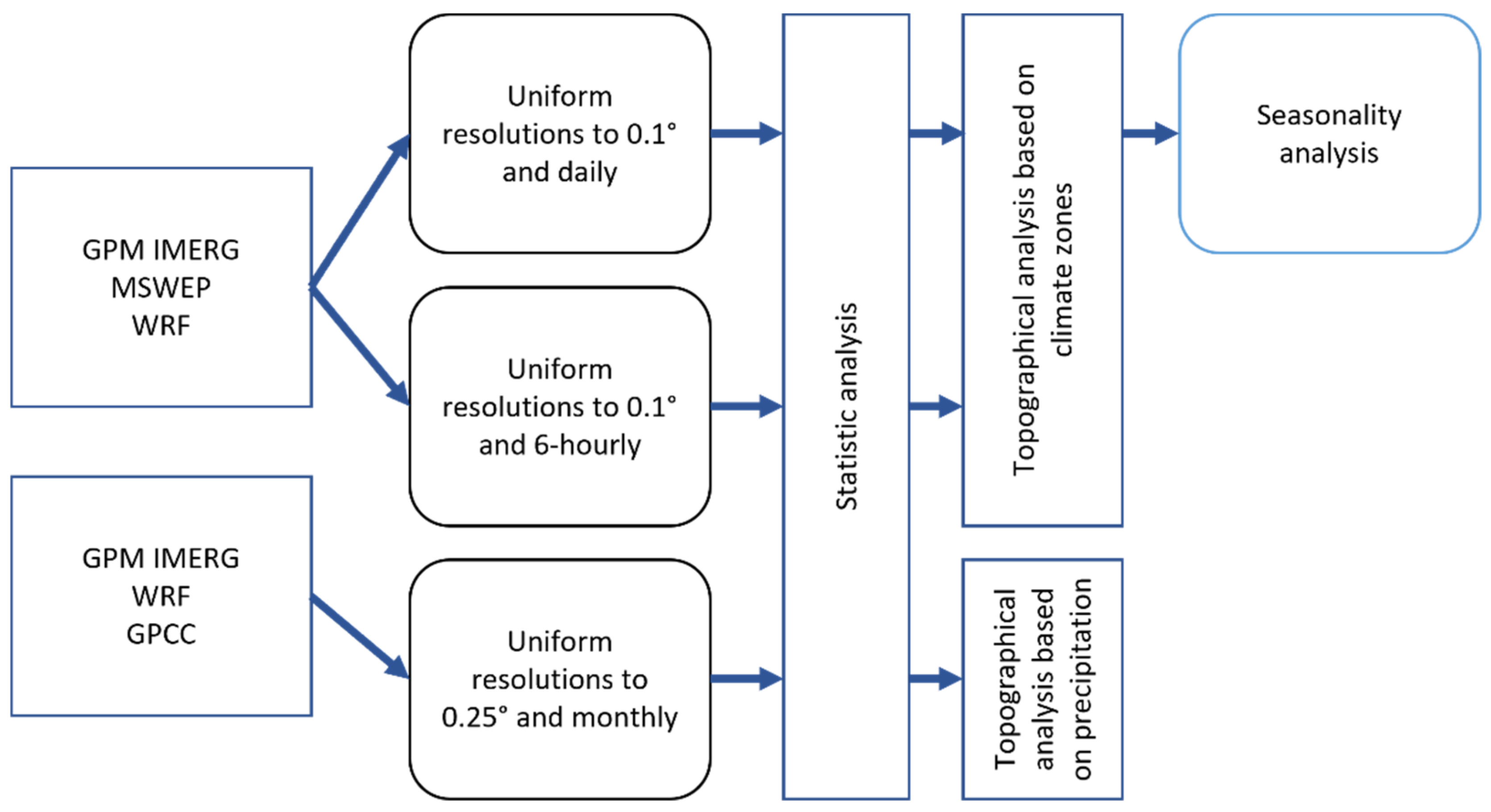
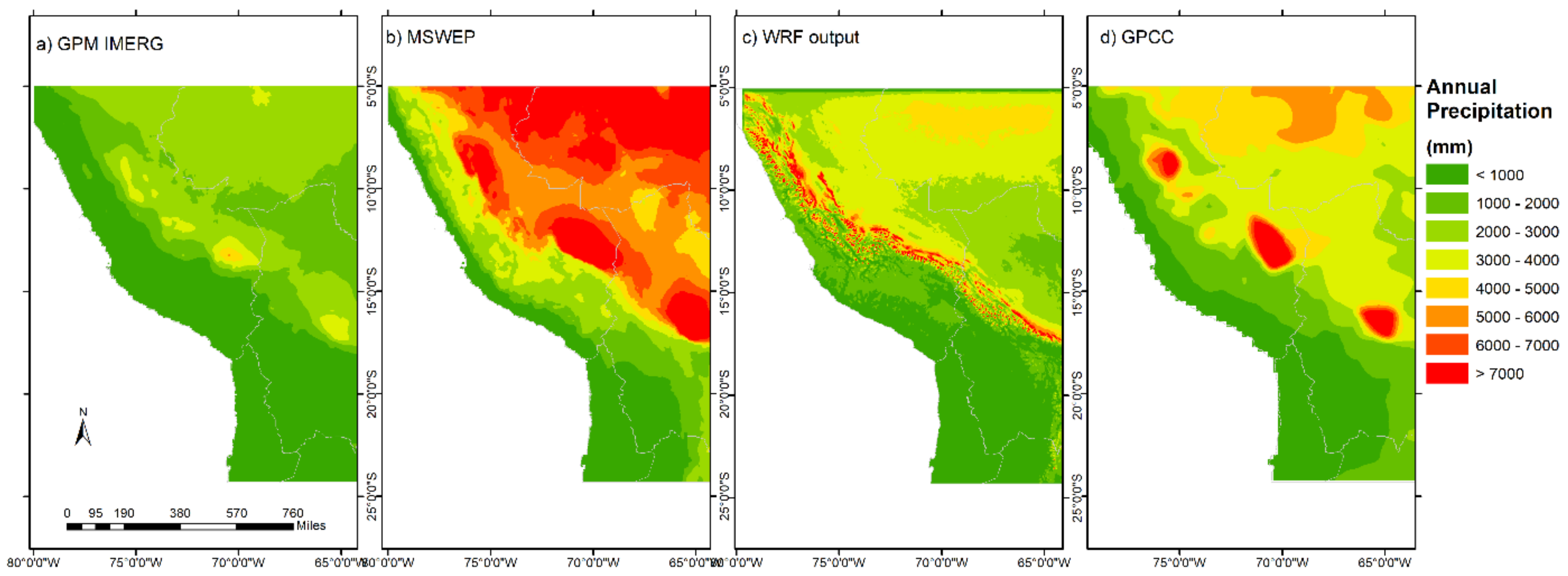
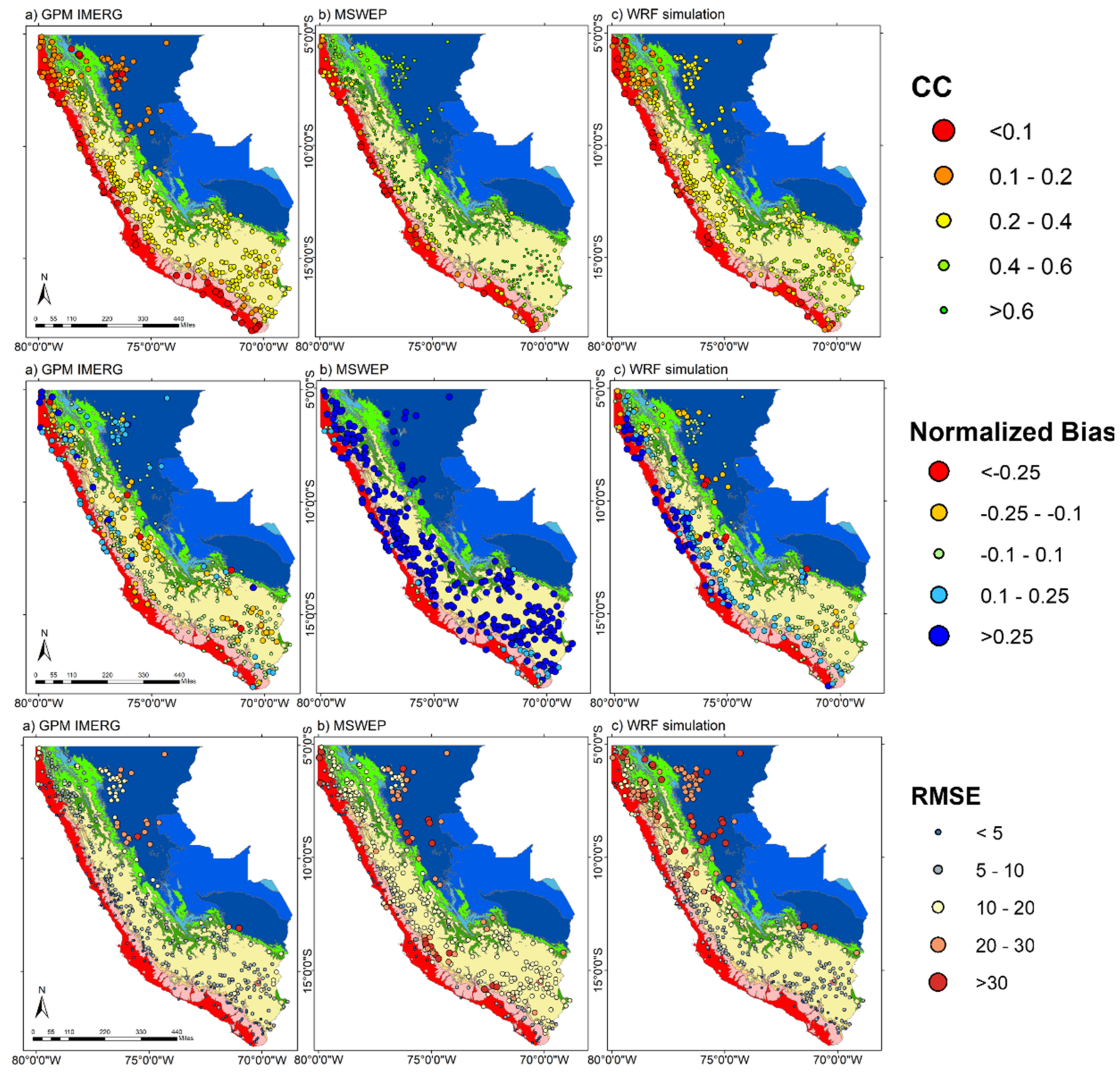
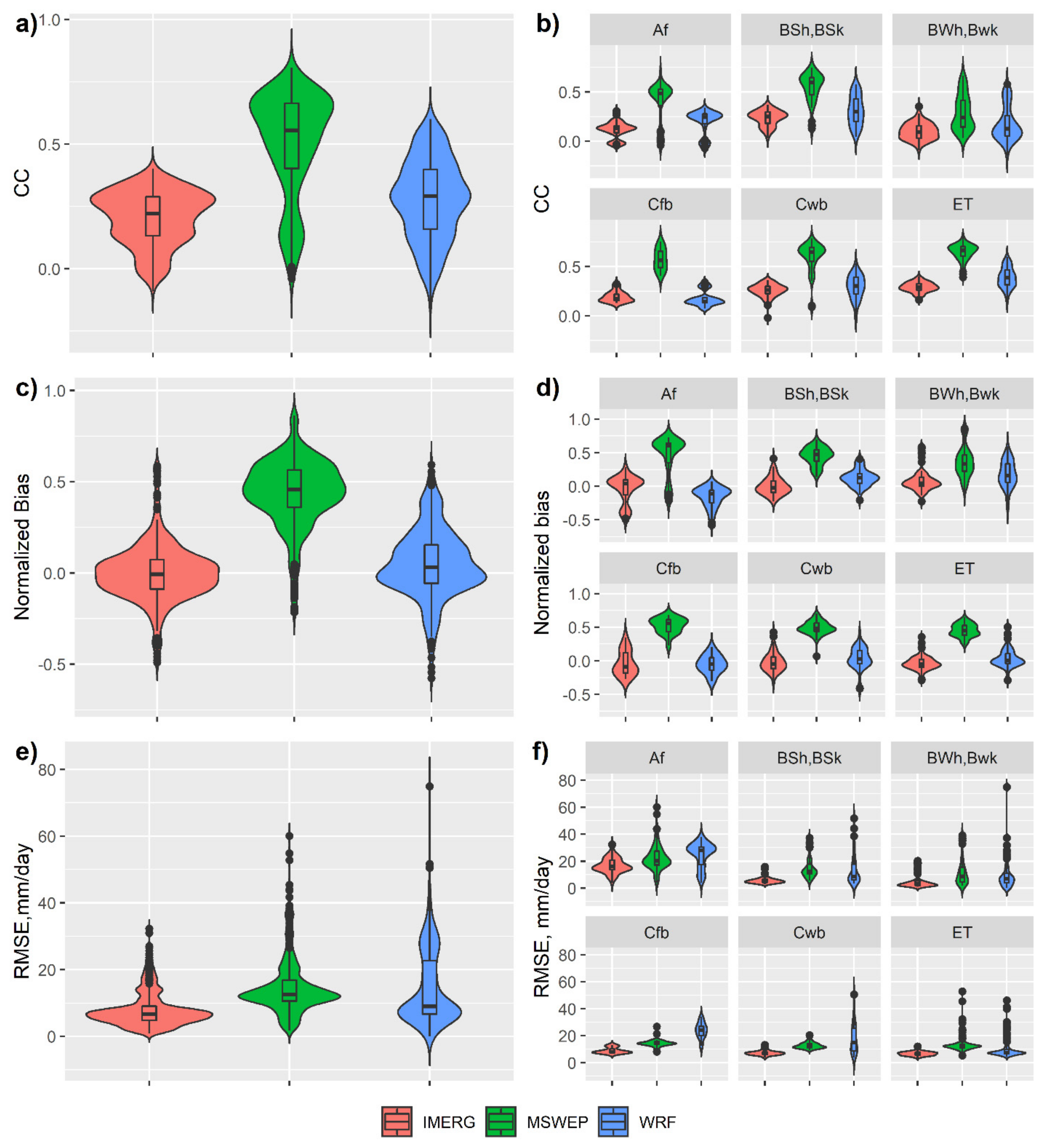
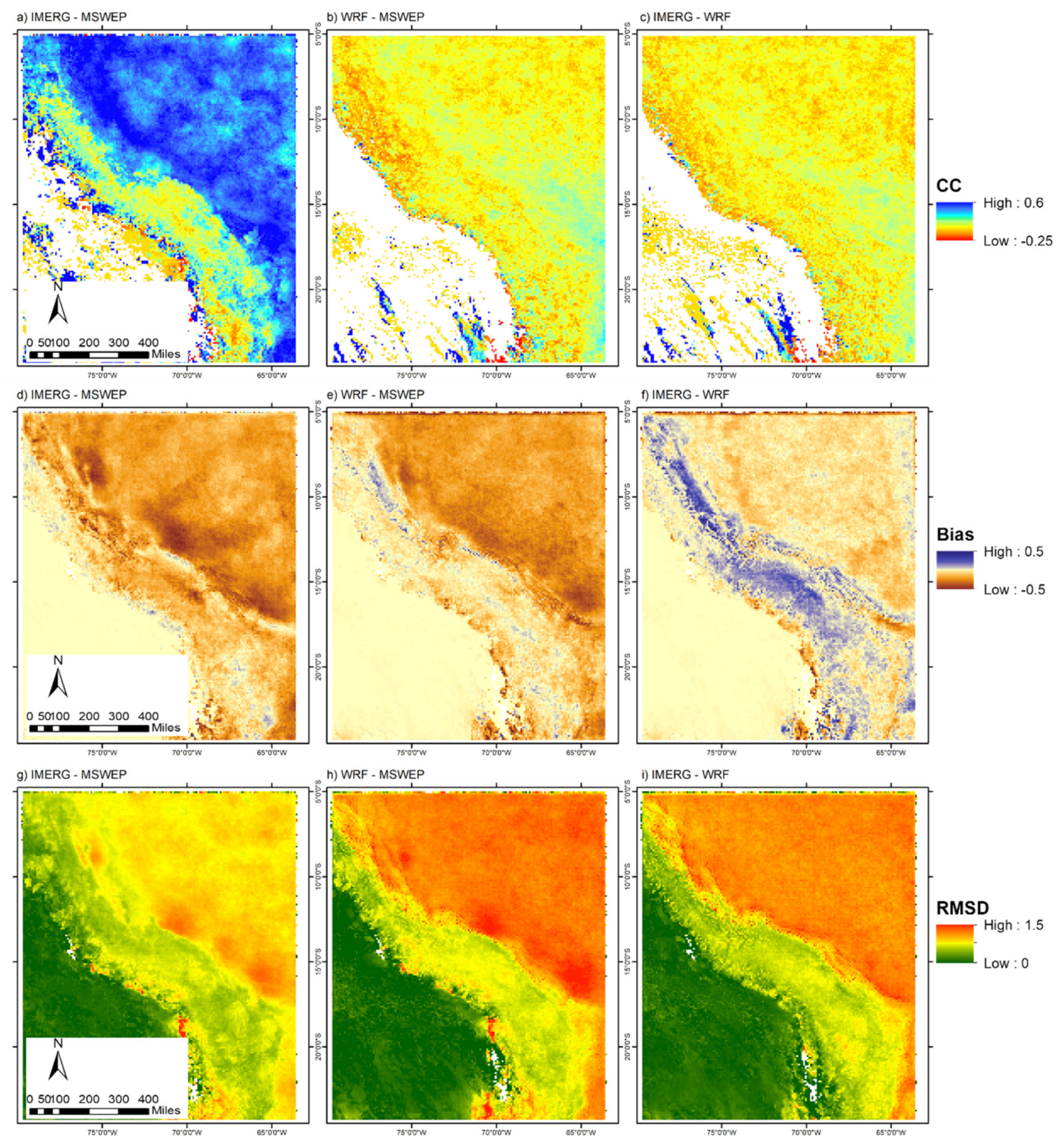
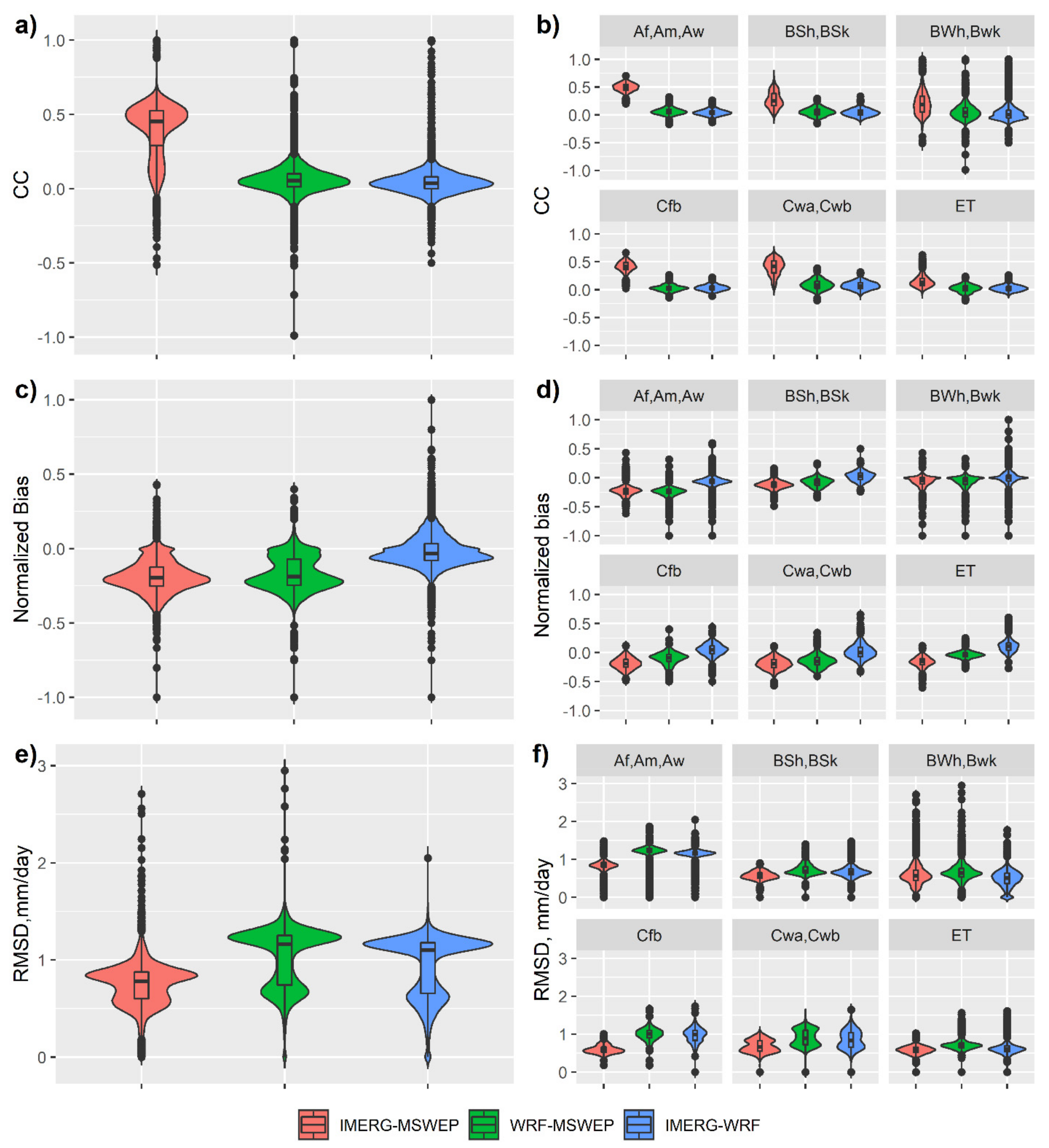
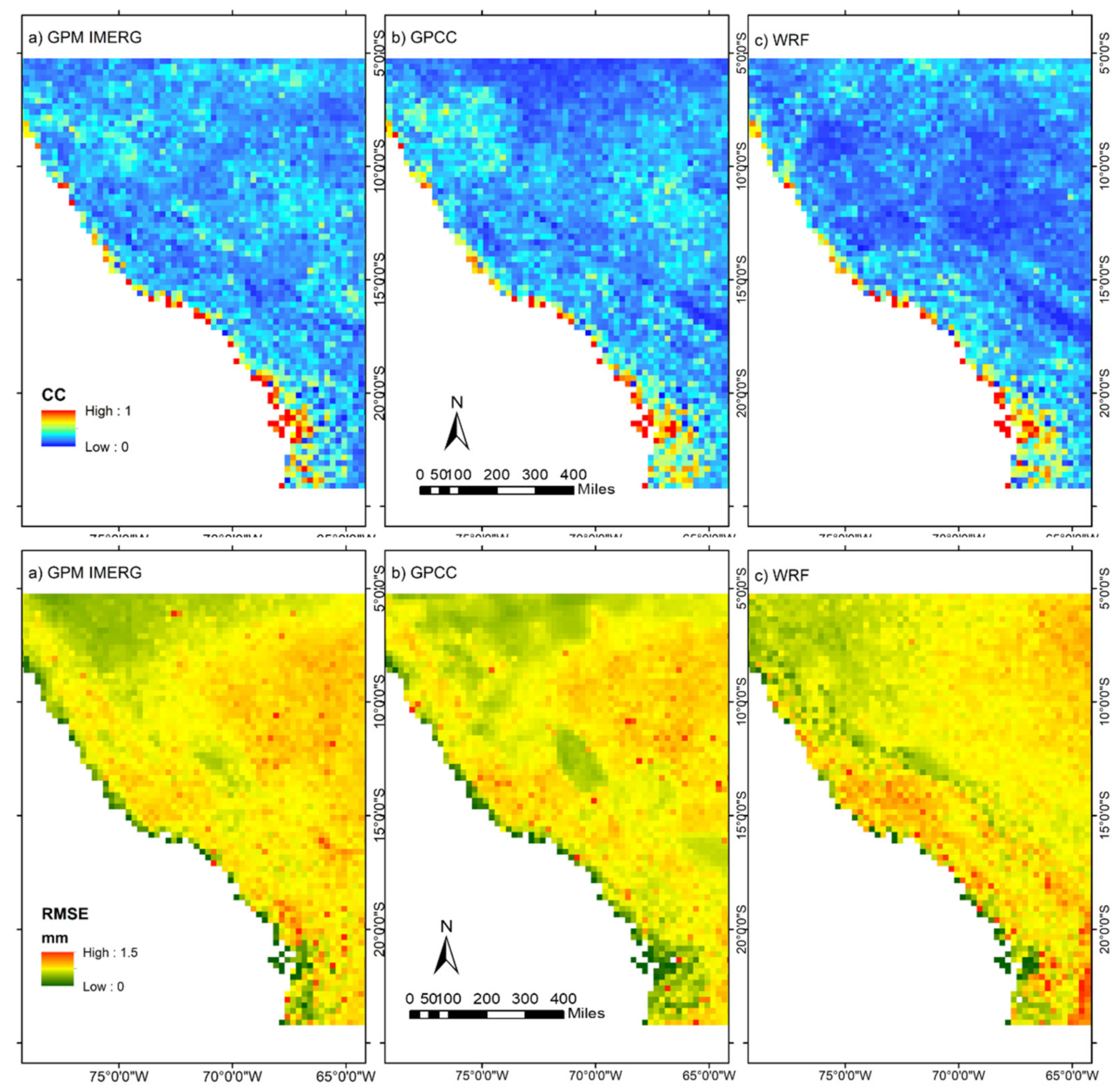
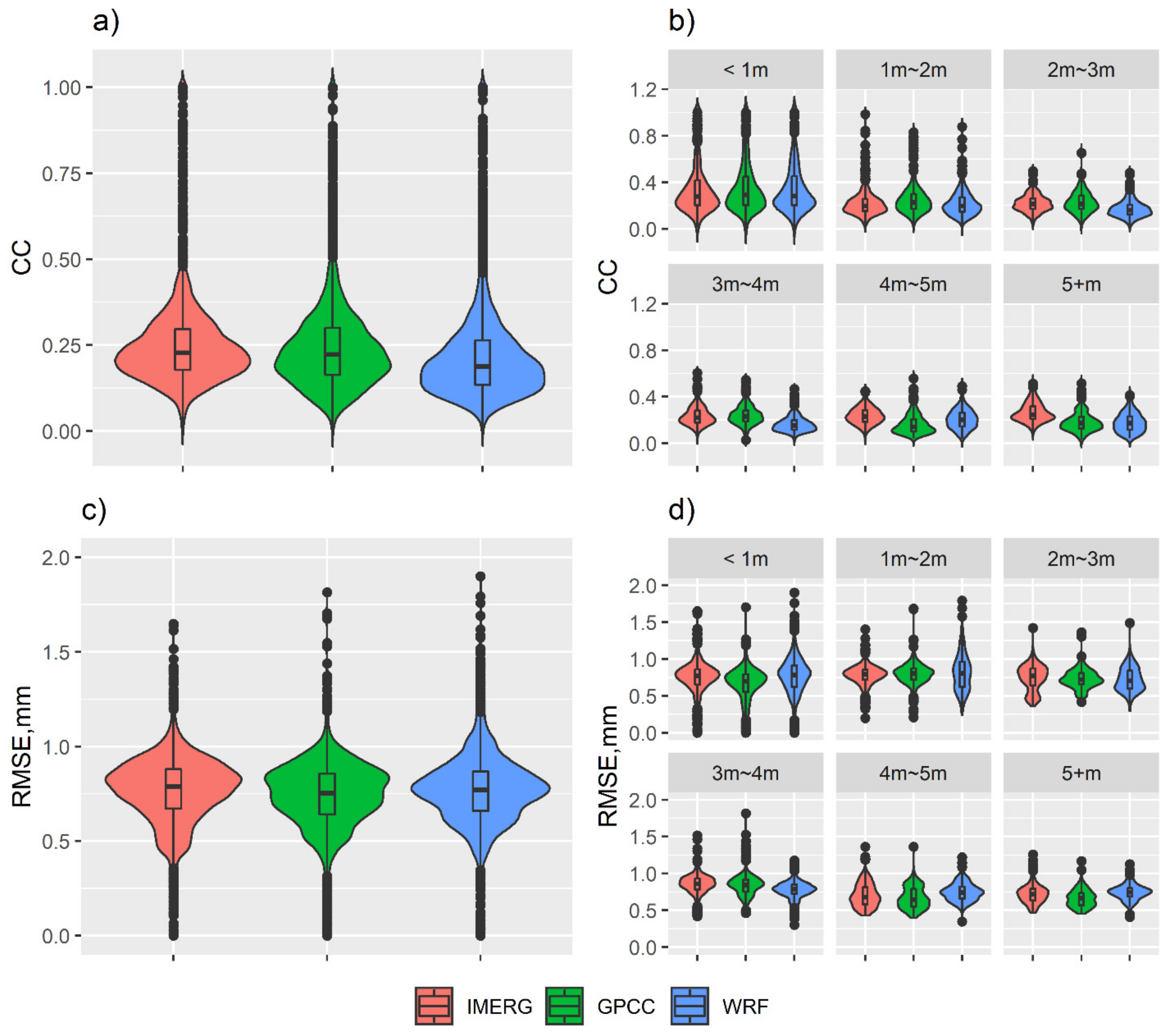
| Resolutions | Annual Averaged Statistics from 2010 to 2019 (mm) | |||||||||||
|---|---|---|---|---|---|---|---|---|---|---|---|---|
| Spatial | Temporal | Min | Median | Mean | Max | SD | 25% | 75% | Skewness | Kurtosis | CV | |
| GPM IMERG | 0.1° | 0.5 h | 5 | 1725 | 1483 | 5094 | 952 | 583 | 2212 | 0.00 | 1.93 | 0.64 |
| MSWEP | 0.1° | 3 h | 14 | 5097 | 4534 | 17,891 | 2259 | 2806 | 6645 | 0.11 | 2.40 | 0.50 |
| WRF | 3 km | 1 h | 0 | 2459 | 2352 | 43,462 | 1765 | 884 | 3367 | 2.39 | 24.41 | 0.75 |
| GPCC | 0.25° | 1 month | 6 | 2916 | 2671 | 12,044 | 1879 | 1131 | 3801 | 0.79 | 4.61 | 0.70 |
| Statistic Metrics | Equation | Value Range | Perfect Value |
|---|---|---|---|
| Correlation coefficient (CC) | −1, 1 | 1 | |
| Normalized bias (NB) | −1, 1 | 0 | |
| Root-mean-square error/difference (RMSE/RMSD) | 0, +∞ | 0 | |
| a Variables: n and N, sample index and a total number of samples; f represents the precipitation estimates; r represents the reference. | |||
| GPM IMERG | MSWP | WRF | ||
|---|---|---|---|---|
| CC | Min | −0.09 | 0.03 | −0.15 |
| Median | 0.24 | 0.59 | 0.30 | |
| Mean | 0.22 | 0.54 | 0.30 | |
| Max | 0.40 | 0.81 | 0.60 | |
| NB (%) | Min | −29.37 | −9.90 | −35.04 |
| Median | −0.72 | 46.94 | 3.67 | |
| Mean | 0.28 | 45.37 | 6.92 | |
| Max | 57.88 | 84.69 | 59.29 | |
| RMSE (mm) | Min | 0.96 | 1.70 | 0.10 |
| Median | 6.37 | 12.35 | 8.50 | |
| Mean | 7.40 | 14.24 | 14.20 | |
| Max | 32.27 | 60.05 | 74.89 |
| CC | Bias | RMSE | Sum | CC | Bias | RMSE | Sum | |
|---|---|---|---|---|---|---|---|---|
| Af: Tropical Rainforest | Cfb: Marine West Coast | |||||||
| IMERG | 3 | 1 | 1 | 5 | 2 | 2 | 1 | 5 |
| MSWEP | 1 | 3 | 2 | 6 | 1 | 3 | 2 | 6 |
| WRF | 2 | 2 | 3 | 7 | 3 | 1 | 3 | 7 |
| BSh, BSk: mid-latitude desert and grassland | Cwb: cold humid subtropical climate | |||||||
| IMERG | 3 | 1 | 2 | 6 | 3 | 2 | 1 | 6 |
| MSWEP | 1 | 3 | 3 | 7 | 1 | 3 | 2 | 6 |
| WRF | 2 | 2 | 1 | 5 | 2 | 1 | 3 | 6 |
| BWh, BWk: tropical and subtropical desert | ET: tundra climate | |||||||
| IMERG | 3 | 1 | 2 | 6 | 3 | 2 | 1 | 6 |
| MSWEP | 1 | 3 | 3 | 7 | 1 | 3 | 3 | 7 |
| WRF | 2 | 2 | 1 | 5 | 2 | 1 | 2 | 5 |
| CC | Jan | Feb | Mar | Apr | May | Jun | Jul | Aug | Sep | Oct | Nov | Dec | |
|---|---|---|---|---|---|---|---|---|---|---|---|---|---|
| Af | IMERG | 0.04 | 0.05 | 0.04 | 0.07 | 0.06 | 0.06 | 0.07 | 0.06 | 0.07 | 0.05 | 0.05 | 0.06 |
| MSWEP | 0.33 | 0.33 | 0.32 | 0.37 | 0.34 | 0.32 | 0.32 | 0.32 | 0.35 | 0.34 | 0.33 | 0.32 | |
| WRF | 0.20 | 0.16 | 0.14 | 0.17 | 0.14 | 0.18 | 0.18 | 0.22 | 0.17 | 0.16 | 0.14 | 0.11 | |
| BSh, BSk | IMERG | 0.12 | 0.08 | 0.09 | 0.11 | 0.05 | 0.04 | 0.05 | 0.03 | 0.07 | 0.04 | 0.04 | 0.05 |
| MSWEP | 0.52 | 0.53 | 0.50 | 0.44 | 0.30 | 0.22 | 0.22 | 0.21 | 0.26 | 0.34 | 0.35 | 0.44 | |
| WRF | 0.23 | 0.16 | 0.18 | 0.21 | 0.13 | 0.17 | 0.16 | 0.14 | 0.12 | 0.12 | 0.14 | 0.11 | |
| BWh, BWk | IMERG | 0.04 | 0.02 | 0.06 | 0.05 | 0.01 | 0.02 | 0.02 | 0.01 | 0.03 | 0.02 | 0.00 | 0.04 |
| MSWEP | 0.29 | 0.33 | 0.30 | 0.20 | 0.16 | 0.16 | 0.16 | 0.12 | 0.11 | 0.15 | 0.13 | 0.23 | |
| WRF | 0.17 | 0.15 | 0.13 | 0.12 | 0.08 | 0.09 | 0.11 | 0.09 | 0.07 | 0.04 | 0.06 | 0.07 | |
| Cfb | IMERG | 0.06 | 0.11 | 0.10 | 0.07 | 0.11 | 0.00 | 0.04 | 0.06 | 0.10 | 0.06 | 0.09 | 0.06 |
| MSWEP | 0.49 | 0.48 | 0.52 | 0.52 | 0.53 | 0.40 | 0.37 | 0.39 | 0.45 | 0.47 | 0.52 | 0.48 | |
| WRF | 0.14 | 0.07 | 0.08 | 0.10 | 0.10 | 0.10 | 0.10 | 0.10 | 0.08 | 0.07 | 0.09 | 0.06 | |
| Cwb | IMERG | 0.07 | 0.07 | 0.09 | 0.08 | 0.06 | 0.02 | 0.04 | 0.03 | 0.07 | 0.06 | 0.04 | 0.03 |
| MSWEP | 0.47 | 0.44 | 0.47 | 0.48 | 0.42 | 0.34 | 0.33 | 0.35 | 0.39 | 0.46 | 0.47 | 0.45 | |
| WRF | 0.16 | 0.11 | 0.13 | 0.17 | 0.17 | 0.20 | 0.21 | 0.24 | 0.14 | 0.11 | 0.12 | 0.08 | |
| ET | IMERG | 0.08 | 0.07 | 0.09 | 0.12 | 0.04 | 0.04 | 0.04 | 0.03 | 0.07 | 0.05 | 0.01 | 0.07 |
| MSWEP | 0.52 | 0.50 | 0.51 | 0.52 | 0.36 | 0.32 | 0.34 | 0.33 | 0.41 | 0.47 | 0.47 | 0.51 | |
| WRF | 0.24 | 0.17 | 0.22 | 0.24 | 0.18 | 0.26 | 0.27 | 0.24 | 0.23 | 0.22 | 0.22 | 0.11 | |
| Bias (%) | Jan | Feb | Mar | Apr | May | Jun | Jul | Aug | Sep | Oct | Nov | Dec | |
| Af | IMERG | −2.42 | −2.18 | −1.48 | −2.41 | −1.83 | −1.37 | −1.63 | −0.09 | −0.57 | −1.57 | −0.58 | −0.93 |
| MSWEP | 1.44 | 3.35 | 3.42 | 3.49 | 3.48 | 2.92 | 2.79 | 3.01 | 3.36 | 3.32 | 3.64 | 3.42 | |
| WRF | −2.59 | −2.38 | −2.97 | −2.82 | −2.65 | −1.83 | −1.42 | −1.02 | −1.23 | −1.97 | −1.69 | −2.08 | |
| BSh, BSk | IMERG | −1.99 | −1.83 | −2.08 | −1.58 | −0.30 | −0.11 | −0.41 | 0.00 | −0.39 | −0.63 | −0.36 | −1.04 |
| MSWEP | 3.60 | 3.68 | 4.31 | 3.37 | 2.29 | 0.76 | 0.43 | 0.84 | 1.48 | 1.62 | 1.53 | 1.93 | |
| WRF | −0.35 | −0.01 | −0.85 | −0.21 | −0.02 | −0.27 | −0.33 | 0.18 | 1.12 | 0.00 | 0.59 | 0.80 | |
| BWh, Bwk | IMERG | −0.31 | −0.50 | −0.35 | −0.07 | −0.18 | −0.22 | −0.48 | −0.35 | −0.09 | −0.24 | −0.06 | 0.14 |
| MSWEP | 2.34 | 2.63 | 2.49 | 1.49 | 1.86 | 1.09 | 0.63 | 0.36 | 1.08 | 0.86 | 0.83 | 1.08 | |
| WRF | 0.74 | 1.36 | 0.92 | 0.23 | 0.17 | −0.24 | −0.35 | −0.02 | 0.85 | 0.44 | 0.76 | 1.54 | |
| Cfb | IMERG | −2.22 | −2.05 | −1.93 | −1.48 | −1.33 | −0.97 | −1.54 | −0.01 | −0.98 | −0.66 | −0.39 | −0.85 |
| MSWEP | 4.61 | 4.01 | 5.04 | 4.96 | 4.73 | 2.95 | 0.48 | 2.68 | 4.03 | 3.68 | 3.84 | 2.57 | |
| WRF | −2.06 | −1.29 | −1.69 | −2.03 | −1.85 | −1.05 | −1.36 | −0.26 | −0.37 | −1.57 | −0.53 | −1.09 | |
| Cwb | IMERG | −1.90 | −1.95 | −1.74 | −1.57 | −0.63 | −0.23 | −0.40 | −0.18 | −1.05 | −0.82 | −0.77 | −1.47 |
| MSWEP | 4.71 | 3.91 | 4.97 | 4.17 | 3.18 | 1.09 | 0.15 | 0.47 | 3.11 | 3.25 | 3.53 | 3.57 | |
| WRF | −0.62 | −0.45 | −1.14 | −1.03 | −0.94 | −0.47 | −0.42 | 0.06 | 0.49 | −0.25 | −0.30 | −0.49 | |
| ET | IMERG | −2.21 | −1.95 | −2.08 | −2.11 | −0.59 | −0.35 | −0.51 | −0.38 | −0.98 | −1.18 | −0.93 | −1.89 |
| MSWEP | 4.81 | 4.36 | 5.07 | 3.40 | 2.75 | 0.35 | 0.35 | 0.26 | 2.33 | 1.82 | 1.98 | 3.14 | |
| WRF | −0.81 | −0.76 | −1.43 | −1.08 | −0.15 | −0.26 | −0.32 | −0.17 | 0.67 | −0.33 | −0.25 | −0.68 | |
| RMSE (mm) | Jan | Feb | Mar | Apr | May | Jun | Jul | Aug | Sep | Oct | Nov | Dec | |
| Af | IMERG | 4.96 | 5.60 | 6.44 | 4.59 | 4.01 | 3.18 | 2.32 | 2.84 | 3.21 | 3.71 | 4.90 | 4.62 |
| MSWEP | 7.01 | 8.47 | 8.89 | 8.24 | 5.11 | 3.67 | 3.36 | 4.00 | 4.82 | 6.48 | 6.99 | 6.82 | |
| WRF | 7.08 | 7.88 | 8.74 | 6.45 | 5.71 | 4.48 | 3.20 | 3.68 | 5.23 | 5.53 | 7.22 | 7.31 | |
| BSh, BSk | IMERG | 2.28 | 2.69 | 3.02 | 1.47 | 0.70 | 0.39 | 0.19 | 0.24 | 0.36 | 0.68 | 0.71 | 1.31 |
| MSWEP | 5.53 | 8.13 | 6.41 | 3.15 | 1.53 | 0.48 | 0.43 | 0.43 | 0.91 | 1.71 | 1.52 | 2.74 | |
| WRF | 3.87 | 4.84 | 4.61 | 3.69 | 2.20 | 0.71 | 0.38 | 1.26 | 2.21 | 2.27 | 2.79 | 3.83 | |
| BWh, Bwk | IMERG | 1.57 | 2.09 | 2.14 | 1.08 | 0.48 | 0.37 | 0.10 | 0.09 | 0.21 | 0.37 | 0.27 | 0.92 |
| MSWEP | 4.18 | 6.05 | 4.29 | 2.59 | 1.33 | 0.94 | 0.44 | 0.37 | 1.05 | 1.14 | 1.37 | 2.43 | |
| WRF | 3.03 | 3.33 | 3.01 | 1.55 | 0.96 | 0.29 | 0.20 | 0.33 | 1.22 | 0.99 | 1.46 | 2.60 | |
| Cfb | IMERG | 2.76 | 3.24 | 3.61 | 2.77 | 2.07 | 1.29 | 0.91 | 1.26 | 1.38 | 2.35 | 2.07 | 2.52 |
| MSWEP | 5.30 | 5.92 | 6.96 | 4.69 | 3.21 | 1.42 | 1.14 | 1.74 | 2.59 | 4.13 | 3.87 | 4.56 | |
| WRF | 6.86 | 7.18 | 8.04 | 6.37 | 4.81 | 3.26 | 2.15 | 3.40 | 3.88 | 5.81 | 7.27 | 7.37 | |
| Cwb | IMERG | 2.73 | 2.90 | 2.94 | 1.77 | 1.14 | 0.55 | 0.48 | 0.54 | 0.89 | 1.54 | 1.54 | 2.45 |
| MSWEP | 4.98 | 5.77 | 5.44 | 3.24 | 1.75 | 0.66 | 0.54 | 0.79 | 1.57 | 3.06 | 2.93 | 4.34 | |
| WRF | 5.81 | 6.13 | 6.08 | 4.51 | 2.56 | 1.38 | 0.88 | 2.05 | 3.59 | 4.30 | 4.84 | 5.45 | |
| ET | IMERG | 2.90 | 2.85 | 2.51 | 1.34 | 0.72 | 0.30 | 0.30 | 0.34 | 0.76 | 1.12 | 1.11 | 2.33 |
| MSWEP | 5.73 | 7.56 | 5.50 | 2.66 | 1.29 | 0.44 | 0.55 | 0.51 | 1.26 | 1.96 | 2.01 | 4.38 | |
| WRF | 3.92 | 4.14 | 3.48 | 2.47 | 1.43 | 0.59 | 0.53 | 0.79 | 2.11 | 2.29 | 2.44 | 3.61 | |
Publisher’s Note: MDPI stays neutral with regard to jurisdictional claims in published maps and institutional affiliations. |
© 2022 by the authors. Licensee MDPI, Basel, Switzerland. This article is an open access article distributed under the terms and conditions of the Creative Commons Attribution (CC BY) license (https://creativecommons.org/licenses/by/4.0/).
Share and Cite
Chen, M.; Huang, Y.; Li, Z.; Larico, A.J.M.; Xue, M.; Hong, Y.; Hu, X.-M.; Novoa, H.M.; Martin, E.; McPherson, R.; et al. Cross-Examining Precipitation Products by Rain Gauge, Remote Sensing, and WRF Simulations over a South American Region across the Pacific Coast and Andes. Atmosphere 2022, 13, 1666. https://doi.org/10.3390/atmos13101666
Chen M, Huang Y, Li Z, Larico AJM, Xue M, Hong Y, Hu X-M, Novoa HM, Martin E, McPherson R, et al. Cross-Examining Precipitation Products by Rain Gauge, Remote Sensing, and WRF Simulations over a South American Region across the Pacific Coast and Andes. Atmosphere. 2022; 13(10):1666. https://doi.org/10.3390/atmos13101666
Chicago/Turabian StyleChen, Mengye, Yongjie Huang, Zhi Li, Albert Johan Mamani Larico, Ming Xue, Yang Hong, Xiao-Ming Hu, Hector Mayol Novoa, Elinor Martin, Renee McPherson, and et al. 2022. "Cross-Examining Precipitation Products by Rain Gauge, Remote Sensing, and WRF Simulations over a South American Region across the Pacific Coast and Andes" Atmosphere 13, no. 10: 1666. https://doi.org/10.3390/atmos13101666
APA StyleChen, M., Huang, Y., Li, Z., Larico, A. J. M., Xue, M., Hong, Y., Hu, X.-M., Novoa, H. M., Martin, E., McPherson, R., Zhang, J., Gao, S., Wen, Y., Perez, A. V., & Morales, I. Y. (2022). Cross-Examining Precipitation Products by Rain Gauge, Remote Sensing, and WRF Simulations over a South American Region across the Pacific Coast and Andes. Atmosphere, 13(10), 1666. https://doi.org/10.3390/atmos13101666











